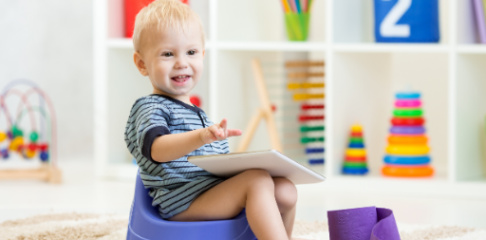Content reviewed and approved by Amanda Jenner, the longest established and most experienced Toilet Training Expert in the UK today, and founder of the Potty Training Academy.
If your little one occasionally wets their bed at night, don’t worry - it’s perfectly natural. Many children learn how to stay dry during the day and night by age four. But some take longer to develop the skill, making the odd night-time accident inevitable.
On this page we’ll share some of the more practical tips on bedwetting treatments you can try at home. Meanwhile, our Bedwetting Advice page offers helpful tips for parents on how to deal with night-time disruptions.
With clothing and clever devices, alongside suggestions around nightly routine, our guide aims to help you and your child get past a difficult time. It includes:
Tools to help prevent bedwetting
At home treatments to help with bedwetting
Tools to help prevent bedwetting
There are several ways to tackle bedwetting, from night time nappies to wee-detecting alarms. Whether used together or on their own, each aims to give your child the confidence they need to have a dry night.
Pull-up pants
Buying pull-up pants for your little one to wear at bedtime should give you the reassurance that, if they don’t stay dry during the night, it won’t cause too much disruption.
Like nappies, pull-up pants like DryNites absorb the moisture and lock it in, so your child doesn’t feel the strange sensation and let it disturb their sleep.
Pull-up pants are, quite visibly, not the same as their everyday underwear. They may be confused at bedtime, or even refuse to wear a pair. So, it’s important they understand that staying dry during the night helps them to sleep better – and worry less.
A bedwetting alarm is like the one on your phone, only it goes off when your child pees rather than when you need to get up for work. It comes with a moisture sensor that can go into your child’s pyjamas or under them on the bed. If your child wees, the sensor detects the moisture and sounds the alarm.
Then you can get up and help them to the toilet to finish. After a few goes, hopefully your little one will know the drill, and feel confident enough to take themselves to the toilet instead.
There are medicines available to reduce how much wee your child makes at night. Speak with your GP first so they can help you decide if it’s really needed.
At home treatments to help with bedwetting
You can treat bedwetting at home using a few simple tweaks to your daily routine.
Amanda says: “Reducing liquids is very important at least one hour before bedtime including fruit. Also making sure during the day they are having regular visits to the toilet, and not rushed ones so they are emptying the bladder fully. Encourage a nice relaxed toilet visit before bedtime and try and get them to sit for at least five minutes.”
Limit fluids in the evening. Encourage your child to drink a little less in the evening – do make sure they have enough to drink during the rest of the day though.
Regular toilet breaks. Give your child regular reminders that it’s time for a toilet visit – it can be hard for them to stop what they’re doing, so make it a fixed part of your routine just like mealtimes or a bedtime story.
Avoid caffeine. Caffeine is found in many fizzy drinks, as well as your tea and coffee. You’ll even find it in foods like chocolate. Caffeine relaxes the muscles in the pelvis and urethra, which may mean more frequent toilet trips. Reducing caffeine should mean fewer overnight disruptions to your child’s sleep and their need to wee.
Double voiding before bed. Double voiding is essentially using the toilet, then using it again. Have your child get comfy and try to use the toilet. Then have them stay there and try again straight away. It increases the chances of completely emptying their bladder, meaning they’re more likely to stay dry overnight.
Keeping a diary. Make notes each day on how your little one got on during the night and look for connections to what you did that day. Even little changes like something new for dinner, fewer visits to the toilet or more fluid intake could be related to nights where your child had an accident.
We know it can be a distressing time for everyone if your little one is struggling to stay dry at night. There are more things you can do to help, as well as a couple of things to avoid.
– Don’t wake your child at night to use the toilet. In the long term, this won’t help.
– Do find out the underlying cause for your child’s bedwetting. A diary might help you to spot patterns in their behaviour.
– Do be encouraging with your child and don’t make them feel like it’s their fault.
– Do see your GP or nurse if six months of dry nights have passed before your child has started wetting the bed again, or if you’ve tried the things you can do at home to help.
– Do try to solve any problems you might be having with daytime dryness. Good habits during the day can translate to the night, but this might take time.
– Don’t worry! Staying dry at night is a huge step and it may take some time before your child reaches that stage.






